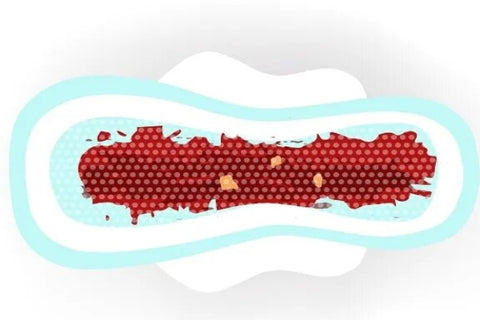Types and colors of menstruation: What do experts say about each one?
Although periods are a common process, many are not familiar with the subject. But don't worry, as in this article, we will discuss the different types and colors of menstruation and what they can mean. First we will review some concepts.
What is menstruation and the menstrual cycle?
Generally speaking, menstruation usually lasts between three and seven days, and occurs once a month. It is a cycle that occurs when the body prepares for fertilization and, if it does not occur, the endometrium is shed and expelled through the vagina.
The menstrual cycle lasts on average about 28 days and begins on the first day of menstruation.
During this time, the body prepares for ovulation, which is when the ovary releases a mature egg.
If the egg is fertilized by a sperm, pregnancy can occur. If there is no fertilization, the body prepares to get rid of the lining of the uterus that has built up during the menstrual cycle. This is what is known as menstruation.
During menstruation, the body may also experience a variety of symptoms, such as abdominal cramps, headache, fatigue, mood swings, and fluid retention.
However, every woman experiences her menstruation differently, and there may be variations in the duration, flow, and color of menstrual blood. Fortunately, technology has helped us have better control of our periods, just take a look here at the best applications you can use to get a closer look at your cycle .
This is where the mystery of the types and colors of menstruation begins: In the endometrium.
The endometrium is a highly vascularized tissue that lines the uterine cavity in people of reproductive capacity.
It is one of the main components of the female reproductive system and is essential for the menstrual cycle and fertility.
According to the journal PLOS, throughout a woman's life, the process of growing, decomposing and regenerating is repeated around 500 times thanks to the endometrium being rich in stem cells.
How does endometrial tissue work?
As we already reminded you above, during the menstrual cycle, the endometrium thickens and prepares for the implantation of a fertilized egg. If fertilization does not occur, the endometrium is shed and menstruation occurs. If fertilization occurs, the fertilized egg attaches to the endometrium and pregnancy begins.
The thickness of the endometrium varies throughout the menstrual cycle, reaching its peak in the luteal phase, which is the second half of the menstrual cycle.
The endometrium also produces a series of chemicals that are essential for the implantation of the fertilized egg and the maintenance of pregnancy.
When fertilization does not occur, all that blood is made up of water, dead endometrial cells, lipids, proteins, hormones, stem cells and, according to a study by scientists and published in the Journal of Chromatography, some organic contaminants such as parabens and benzophenones, products used for women's personal care.
This bleeding can last from three to a week. According to experts, everything will depend on whether the woman suffers from some type of anomaly, such as fibroids, for example.
Additionally, it is important to note that excessive growth of the endometrium outside the uterus, as in the case of endometriosis, can cause pelvic pain, menstrual irregularities and even infertility.
- You may be interested in: 15 reasons that can explain why you got your period twice during the same month
Therefore, the endometrium plays a vital role in reproductive health and should be monitored and treated appropriately in case of any abnormality.
Before explaining the types and colors of menstruation, we want to detail the duration of menstruation.
Why does my period last only a few days?

The duration of the menstrual period varies from woman to woman, and on some occasions it can last a few days. If your menstruation lasts less than usual, you may be wondering why and here we will tell you some of those questions:
Short menstrual cycle
If your menstrual cycle is shorter than normal, your period may also be shorter. The menstrual cycle refers to the time between the first day of your period and the first day of your next. The average menstrual cycle lasts about 28 days, but it can vary from 21 to 35 days and is sometimes accompanied by constipation. We explain the causes .
Hormonal imbalance
Hormonal imbalances can affect the length of your menstrual period. Hormonal imbalance can be caused by thyroid problems, polycystic ovary syndrome (PCOS), or other hormonal disorders.
Stress
Stress can affect your menstrual cycle and make your period shorter than normal. When the body is stressed, it produces hormones like cortisol that can interfere with the production of sex hormones.
Why does my period last so many days?
There are several reasons why your period may last longer than usual, some of which include:
Hormonal changes
Hormonal levels can alter the length of your menstrual period. This can occur due to certain medications, thyroid disorders, or reproductive health problems.
Endometriosis
This is a condition in which tissue that normally grows inside the uterus begins to grow outside of it. This can cause severe and prolonged menstrual pain.
Uterine fibroids
These are non-cancerous tumors that grow in the uterus and can cause long, painful menstrual periods.
Blood clotting disorders: Some blood clotting disorders can cause prolonged and painful menstruations.
Intrauterine devices (IUD)
Some types of IUD can cause more uncomfortable and painful days.
Types of menstruation
Flow with pieces of skin

According to the Brazilian gynecologist Celso Luiz Borrelli, from the Hospital del Corazón de São Paulo, it is normal that at a time during menstruation some women notice that little pieces of skin come out with blood, since as you will remember, the endometrium is a tissue which is created in the inner wall of the uterus and this is what gives rise to the period.
light flow
This type of menstruation is characterized by light blood flow that can last between one and three days. Menstrual blood in this case can be light pink or brown.
According to Borrelli , the ingestion of the synthetic hormone (contraceptives) thins the endometrium and, therefore, the amount of bleeding decreases. It could also be due to other causes such as hormonal alterations common in puberty and the onset of menopause.
normal flow
Most of us experience this type of menstruation, which is characterized by moderate blood flow that lasts between three and five days. Menstrual blood in this case is dark red or brown.
abundant flow
Some women may experience heavy menstrual flow, which means they lose a large amount of blood in a short time. In this case, menstrual blood may be bright red and have clots.
From the Mandaqui Hospital in São Paulo, they explain that this is due to the amount of hormones produced while the uterus prepares to receive the fertilized egg by producing the endometrium.
Flow with clots
Clots during menstruation are very common. The specialist explains that this is because during the descent of the blood it accumulates in the cavity of the vaginal canal, and the body transforms it into a clot.
The accumulation of blood will depend on some women, that is, if they stay in one place or do not exercise.
And although it is very normal, it is very important that if clots occur excessively, you can consult your doctor since it could be related to some diseases of the female reproductive system such as fibroids or endometrial polyps. .
Menstruation colors

The color of menstruation can vary from one woman to another and from one menstrual cycle to another. The color of menstrual blood can be bright red, light pink, dark brown, or even black.
Colors you don't have to worry about
Bright red
Bright red menstrual blood is the most common color of menstruation. This color usually indicates that the blood is fresh and is being removed from the body quickly. It is normal to experience this color at the beginning of your period.
light pink
Light pink menstrual blood may be an indication that menstrual blood has mixed with the cervical mucosa. This may be common at the beginning or end of your menstrual cycle.
Dark blood
The gynecologist specializing in fetal medicine Jurandir Pasos, from the Delboni Medicina Diagnóstica clinic, explains that this condition is due to the little flow that some women experience.
The expert assures that it is completely normal at the beginning or end of menstruation. But not all are good news. It is important that if this characteristic occurs throughout your period, you should consult your doctor because it may be a symptom of another problem, such as endometriosis. The dark color can be brown or black.
Colors you have to watch
Pale pink or whitish
If your menstruation is very watery and very light in color, it is important that you consult a specialist, as it could be due to severe iron deficiency anemia. But you don't have to be alarmed because your doctor could treat this condition with iron supplements.
Small light colored spots
If you are trying to become a mother and this occurs before you have your period, it is possible that it is a symptom of pregnancy and is due, according to experts, to implantation bleeding or false periods that occur when the egg is already fertilized. On the other hand, it can be a symptom of a hormonal imbalance, so it is important to consult with your doctor.
Orange or yellowish red
If your menstruation has an orange-red or yellowish color, it may be an infection, and if this color is accompanied by a "fishy smell," it is better that you go to your trusted doctor.
Gray with red threads
If you have grayish spots with red threads, perhaps you could have suffered or are suffering from a spontaneous abortion, so you should go to the emergency room to be treated by a specialist as soon as possible. It could also be a sexually transmitted disease.
It is important to note that the color and consistency of menstrual blood can be influenced by several factors, including the woman's age, hormonal changes, dietary changes, and lifestyle changes.
Additionally, women who use hormonal birth control, such as the birth control pill, may experience changes in the amount and color of menstrual blood.
From our blog, we always recommend that you consult your doctor if you notice very unusual persistence regarding the type and color of your menstruation.
Now, as we are concerned about your menstrual health, we also want to leave you with some recommendations to avoid an abnormal menstrual cycle.
How to maintain a healthy menstrual cycle?
- Maintain a nutritious and balanced diet : A healthy diet is essential to maintain a healthy and regular menstrual cycle. 1 2 . It is important to eat nutrient-dense foods, such as fruits, vegetables, lean proteins, and whole grains. Look at what things you can eat and what you can't when you have your period .
- Maintain a healthy weight : Being overweight or being very underweight can affect the menstrual cycle. Try to maintain a healthy weight through healthy eating and regular physical activity.
- Practice regular physical activity : Regular physical exercise can help maintain a regular and healthy menstrual cycle 1 2 . It is recommended to do at least 30 minutes of moderate physical activity a day.
- Control your stress : Stress can affect the menstrual cycle and cause irregularities. Try to live a balanced lifestyle and practice relaxation techniques, such as meditation, yoga, or deep breathing.
- Avoid tobacco and alcohol consumption : Tobacco and alcohol consumption can affect the health of the reproductive system and cause irregularities in the menstrual cycle. Try to avoid these habits to maintain a healthy menstrual cycle.
These articles may interest you:
- 10 reasons why menstruation may be delayed, according to experts
- What is the rhythm method for menstruation and how does it work?
- The 15 hygienic habits related to menstruation that all women should know
- How do you know when the first day of your period is ? How do I know if my menstrual cycle is normal?
Frequent questions
What is the normal color of menstruation?
The tone of menstruation can vary from very light colors to darker tones due to various factors, such as the stage of the menstrual cycle we are in or the type of menstrual products we use, such as menstrual panties , tampons or menstrual cups. Therefore, it is not a cause for concern if we observe changes in the color of menstrual blood throughout the cycle, since it is normal for some variation in shade to occur during these days. The coloration of blood and tissues can change depending on how long they have been exposed to air oxidation.
Should I worry if I get lumps during my period?
You don't necessarily need to worry if you experience lumps or clots during your period . The presence of small to moderate clots in the menstrual flow is actually quite common and is not usually a cause for alarm, as they indicate that endometrial tissue has broken away from the inner layer of the uterus.
Choose comfort during your menstruation: discover our menstrual panties

Click for a personal revolution.
They're cool, I really liked them a lot. And they are very pretty. I want to buy another model to see how it goes.
I loved. It is super comfortable, I loved the material, it exceeded the expectations I had, I was a little afraid of using it and having accidents, however it worked super well for me!
It is very soft and comfortable. I don't know what happens even a little bit



















